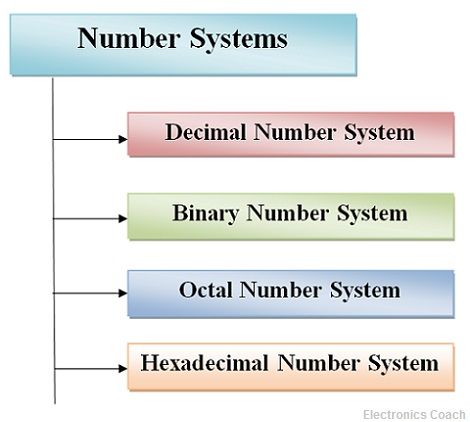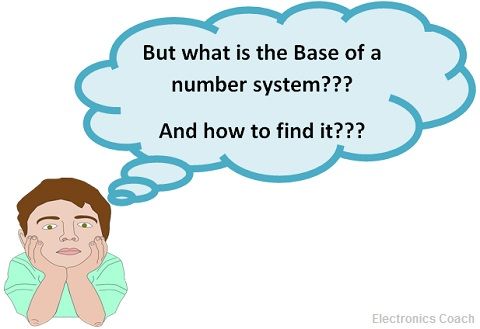Computers understand machine language. Every letter, symbol etc. that we write in the instructions given to computer, it gets converted into machine language. This machine language comprises of numbers. In order to understand the language used by computers and other digital system it is crucial to have a better understanding of number system.
Number systems can be classified into its sub-types on the basis of base of that system. Base of a number systems plays crucial role in understanding the number system and to convert it from one sub-type to other sub-type. Base is also sometimes referred as radix; both these terms have same meaning.
The classification of numbers systems on the basis of base can be understood from the below diagram.

Thus, we have four major types of number systems that are binary, decimal, octal and hexadecimal. To understand it we should know the base of the particular number system.

You must be thinking that what is this base terminology in the number systems? Base can be defined as the number of digits which are available in the number system for expressing any digit in that particular number system.
This term is significant in the conversion process also. For ex: Decimal means 10 thus decimal number system are called so because the base of the decimal number system is 10.

Key components to find the value of digit in a number systems
In order to find the value of digit in a particular number systems we need to have three basic components. They are as follows:
- The digit itself.
- Position of the digit in a particular number.
- Base of the number system.
Now, let’s discuss each of the sub-type of number systems briefly.
Decimal Number System
Decimal Number System comprises of 10 digits. These digits are 0, 1, 2, 3, 4, 5, 6, 7, 8 & 9. The base of the decimal number system is 10 because total 10 digits are available in the number system. It does not implies that only 10 digits can be expressed in decimal numbers system but using these 10 digits we can define any number in this system no matter how large it is.
Two significant terms are associated with any number and that are its place value and face value. Face value is the digit itself while the place value is the magnitude that the digit represents.
Consider a number 7896, in this number the face value of 8 is 8 while its place value is 100.
Expansion of Decimal Number: Consider the above number again i.e. 7896.
Now, it can be written as:-
7896 = 10007 + 1008 + 109 + 6
To write a number in terms of base 10, we can use the positional value as superscript of base 10.
7896 = 1037 + 1028 + 1019 + 1006
Binary Number System
Binary Number System consists of two digits only i.e. 0 & 1. This makes it less complicated than any other number system since it comprises of only two digits. Thus, the base of the binary system is 2 as the available digits in this number system is 2. The other numbers can be expressed with these two digits.
Binary digits are called as Bits, it is formed from two words Binary and Digits. 4 Bits together are called as nibble and 8 bits together is called as byte. Binary digits are useful for computation of results of devices which have two states ON and OFF.
Decimal equivalent of Binary can be calculated by multiplying the binary digits with 2 to the power of positional values of respective digits.
10011 = 241 + 230 + 22 + 211 + 201
= 16 + 2 + 1
= 19
Octal Number System
Octal Number System comprises of 8 digits i.e. from 0, 1, 2, 3, 4, 5, 6 & 7. Thus, the base of Octal Number System is 8. It is much easier to handle array of octal numbers in comparison to binary numbers. This is because if we represent any number using binary digits it will be a long array of binary numbers. While in case of Octal numbers the array of numbers will be less.
Decimal Equivalent of Octal Number: The decimal equivalent of Octal number can be evaluated by multiplying the digits with 8, and the base 8 will be raised to the positional value of the respective digit.
Let’s consider an octal number 431, now its decimal equivalent can be described as:-
431 = 824 + 813 + 801
= 256 + 24 + 1
= 281
Hexadecimal Number System
It comprises of 10 digits and 6 alphabets. The 10 digits from 0, 1, 2, 3, 4, 5, 6, 7, 8 & 9 and the alphabets used are A, B, C, D, E & F. All the other numbers can be expressed with the help of combination of these digits and alphabets. A, B, C, D, E, F represents 10, 11, 12, 13, 14 & 15 respectively.
The base of the hexadecimal number system is 16 as total 16 elements are available in this number system. Thus, Hexadecimal number system is used mostly in case of microprocessors and microcontrollers.
Decimal Equivalent of Hexadecimal Numbers: Let’s consider a hexadecimal number 5B52, now its decimal equivalent can be calculated by multiplying each digit with 16 and 16 will be raised to the power of positional value of the respective digit.
5B52 = 163 5+ 162 11+ 1615 + 1602
= 54096 + 11256 + 80 + 2
= 23378
Significance of Number Systems
Number Systems is crucial for understanding the processing of digital system. Digital system takes binary, octal & hexadecimal number as input and process it and generates output. Thus, in the field of information technology or embedded system everywhere one need to be well aware of number system in order to understand its operation.
soha says
nice article
Dhanesh Singh says
Thank you very much
Nischay Balani says
Thanks a lot and all the doubts are cleared very promptly in an efficient manner.
Twinkle says
This helped me, thanks 👍
sylvia says
Nice job.